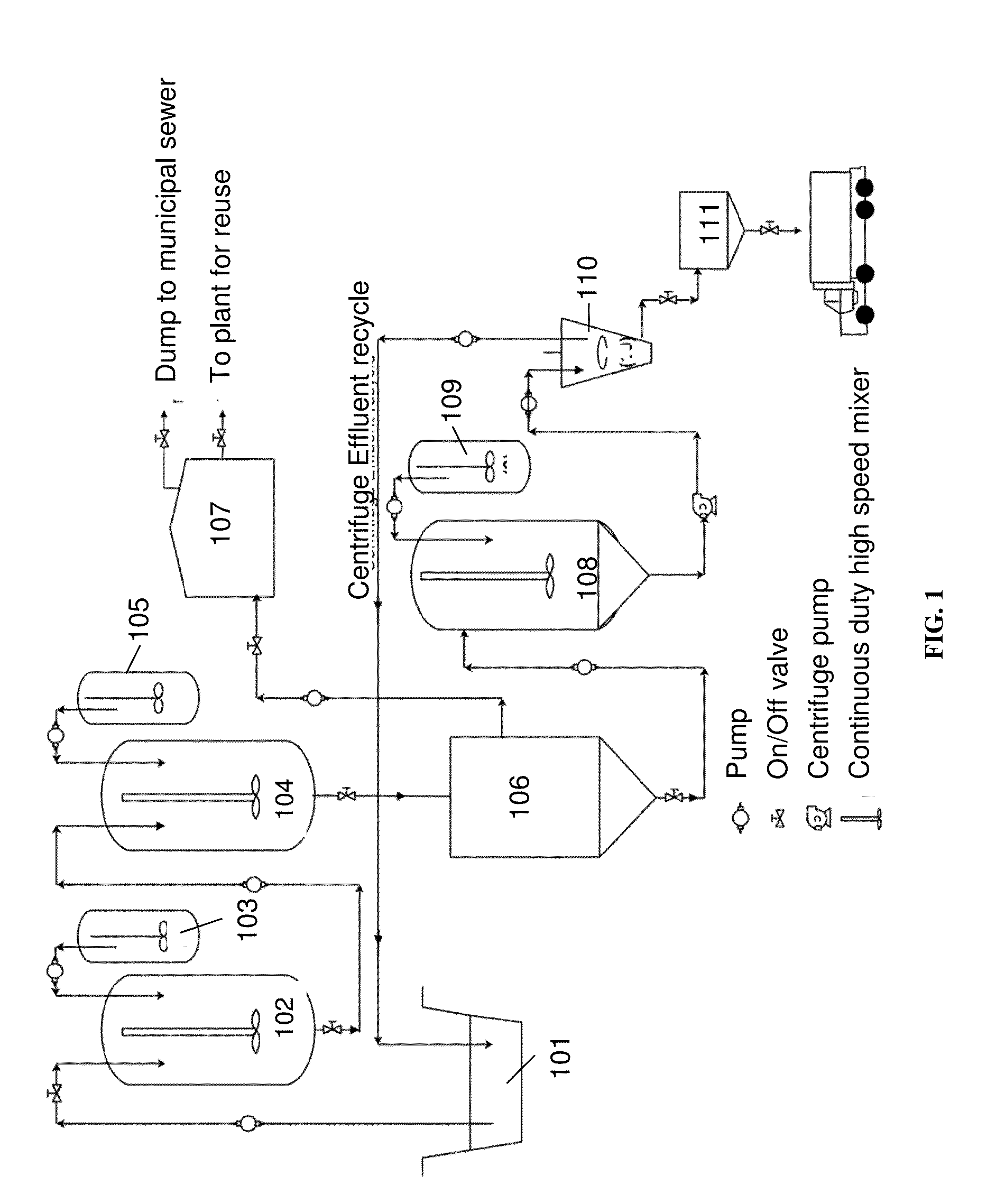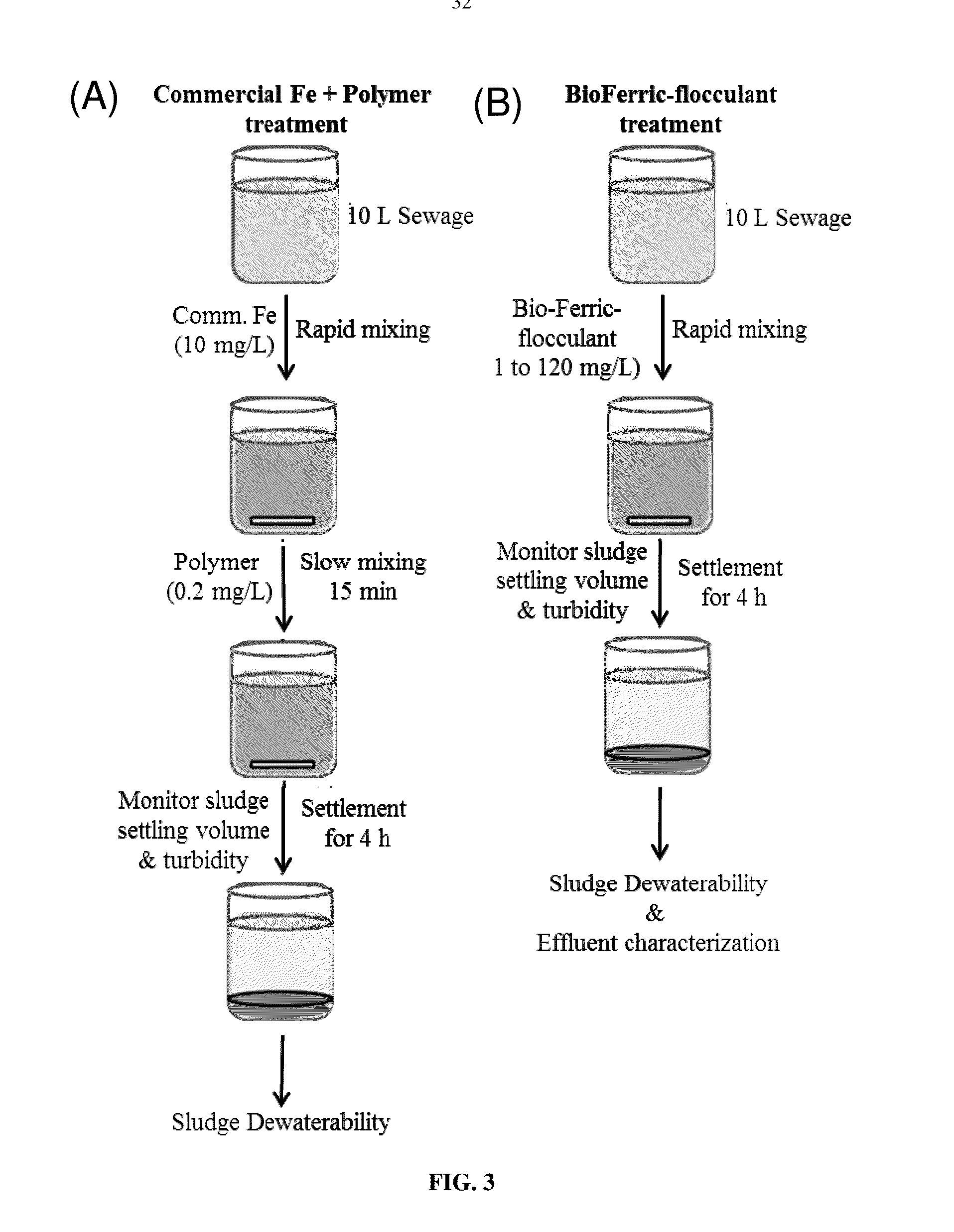BioFerric-Flocculant Enhanced Primary Treatment Process (BEPT) for Sewage Treatment
a bioferric flocculant and primary treatment technology, applied in biochemical equipment and processes, biological water/sewage treatment, microorganisms, etc., can solve the problems of increasing the total dissolved solids (tds), reducing the efficiency of sewage treatment, and reducing the amount of sewage. , to achieve the effect of enhancing the primary treatment process, reducing the chemical use and steps, and enhancing the sewage treatment process
- Summary
- Abstract
- Description
- Claims
- Application Information
AI Technical Summary
Benefits of technology
Problems solved by technology
Method used
Image
Examples
example 1
Sludge Collection and Characterization
[0033]The Municipal sewage sample is collected from the centralized sewage treatment works at the Stonecutters Island (SCISTW) in Hong Kong, Special Administrative Region, China, which serves a population of around 3 million and provides Chemically Enhanced Primary Treatment (CEPT) to 75% of the Harbor sewage effluents (1.4 million m3 d−1) by the addition of FeCl3 and anionic polymer. The raw sewage sample is collected in clean 10 L polypropylene containers, which are stored at 4° C. for further use. The properties of raw sewage are pH 7.26; TSS 266±4 mg / L; TDS 11730±650 mg / L; OD 254 nm 0.318±0.004; COD 320±5.21 mg / L; phosphate 3.86±0.03 mg / L.
example 2
Preparation of Composite BioFerric Flocculant
[0034]To prepare the BioFerric flocculant acidophilic microbial consortium consisting of iron-oxidizing bacteria Acidithiobacillus ferrooxidans ANYL1 and heterotrophic bacteria Acidophilum sp. BL1 are grown in an aqueous buffered medium with pH (2˜3) consisting of 3.0 g of a substrate delivering nitrogen, 0.5 g / L of a substrate releasing potassium ion, 0.01 g of a substrate providing calcium ion, 0.5 g / L of a substrate consisting of magnesium, 22.11 to 44.22 g / L of a substrate releasing iron (II) ion, and with or without a substrate supporting carbons source. The specific consortium grown in this medium generates BioFerric flocculant in different range of conditions.
[0035]A five hundred milliliters (500 mL) flask contains 200 ml of said medium or sludge effluent with a substrate releasing iron (II) ion in the medium in a concentration from 4.42 to 8.84 g / L for growth of JOB. The flasks are inoculated with 5˜10% bacterial seed culture and ...
example 3
Coagulation and Flocculation of Sewage
[0036]Sewage coagulation-flocculation experiments are performed in a polyethylene 15 L container at room temperature as shown in the process flows for CEPT and BEPT respectively (FIG. 3A-B). Raw sewage (10 L) is transferred into the container and subjected for rapid mixing initially at 150 rpm for 1 min. This is followed by addition of composite BioFerric flocculant delivering iron at different concentrations that varies between 1 and 120 mg / L. Then, the sewage is subjected to continuous stirring at 50 rpm for 15 minutes. After completion of mixing stage, the flocculated sewage is allowed to settle for 1˜4 hours. Then, sample is collected at regular time intervals from the supernatant portion for pH, turbidity and nutrient analysis. After 4 hours of settlement, the supernatant (effluent) and settled sludge are separated from the container to analyze their properties and assess their dewaterability.
PUM
| Property | Measurement | Unit |
|---|---|---|
| pH | aaaaa | aaaaa |
| concentration | aaaaa | aaaaa |
| temperature | aaaaa | aaaaa |
Abstract
Description
Claims
Application Information
 Login to View More
Login to View More - R&D
- Intellectual Property
- Life Sciences
- Materials
- Tech Scout
- Unparalleled Data Quality
- Higher Quality Content
- 60% Fewer Hallucinations
Browse by: Latest US Patents, China's latest patents, Technical Efficacy Thesaurus, Application Domain, Technology Topic, Popular Technical Reports.
© 2025 PatSnap. All rights reserved.Legal|Privacy policy|Modern Slavery Act Transparency Statement|Sitemap|About US| Contact US: help@patsnap.com



